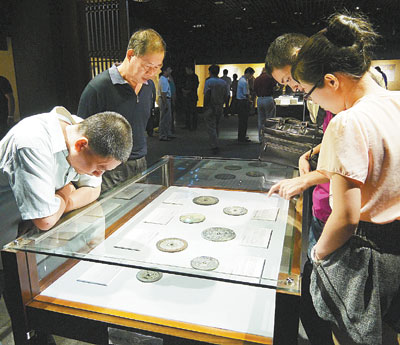|

Cao Zhen
caozhen0806@126.com
LI SHIMIN, the best known emperor of the Tang Dynasty (618-907), once said: “Using bronze as a mirror allows one to keep his clothes neat. Using history as a mirror allows one to predict the future. Using a person as a mirror allows one to see what is right and wrong.” For some scholars of Chinese culture, the broad sweep of history is reflected in a particular art form: exquisitely crafted ancient mirrors made of bronze.
“Mirroring the Spring and the Autumn — Ancient Chinese Bronze Mirrors,” an exhibition of 280 Chinese bronze mirrors spanning 3,000 years, is being held at Shenzhen Museum and will continue until Feb. 22, 2013.
The highly decorative mirrors range in date from the Shang Dynasty (1600-1046 B.C.) to the Ming Dynasty (1368-1644). They are provided by private collectors of Shenzhen Collection Association and China Bronze Mirror Research Association.
Bronze technology was highly developed in ancient China, and objects made from this alloy of copper and tin were considered luxury items, reserved for the aristocratic class. Cast from clay molds, the ancient bronze mirrors were usually circular, with one side polished bright to give a reflection and the reverse side with intricate patterns and designs that reveal an astonishing level of skill and craftsmanship.
The mirrors often had a knob in the center so that they could be attached to a handle or tied to a garment. With their reflective sides turned to the back and their intricately decorated surfaces facing viewers, the mirrors demand close inspection because they appear identical but vary widely in exquisitely wrought designs and inscriptions.
The ancient mirrors are more than vanity objects. Centuries of craftsmanship, aesthetic taste, dynastic change, philosophy, and consumer culture are revealed. They can be records of the thoughts, culture, religion, folk custom and technology of their time, as Yang Chuangeng, director of Shenzhen Collection Association, pointed out at the opening of the exhibition Saturday.
According to Yang, China’s earliest bronze mirrors were produced in the Qijia Culture (2400-1900 B.C.), an early Bronze Age culture distributed around the upper Yellow River region of Gansu and eastern Qinghai. During the Warring States Period (475-221 B.C.), bronze mirrors became particularly popular thanks to a large output of bronze and improvements in metallurgical technology. Geometry patterns and ferocious beasts’ faces, as well as mythological animals (dragons and phoenixes), were common motifs of the mirrors, showing humans’ respect for and fear of nature.
It was during the Western Han Dynasty (206 B.C.-A.D. 25) that mirrors started to be mass-produced due to the country’s economic prosperity. Compared with Warring States mirrors, the Western Han ones were thicker. In the Eastern Han Dynasty (25-220), relief carvings on mirrors became a significant feature.
Written characters were also incorporated directly into the design. These inscriptions were often auspicious phrases, bearing good wishes for the owners.
Both Han and Tang (618-907) mirrors are considered to be the most technically advanced due to the prosperity, stability, and flourishing culture of the Tang Dynasty. Shapes of bronze mirrors were not limited to circles or squares. Sunflower- and lozenge-shaped mirrors appeared.
Ferocious beasts were not seen on the Tang mirrors, while birds and flowers and Chinese legends were popular.
As the Silk Road opened up trade routes to and from India, Persia, and Egypt, new aesthetic elements borrowed from the West began to appear in the Tang mirrors’ design. Twisting grapevines, floral motifs, and intricate silver fretwork overlaid on bronze added exotic allure to these symbols of wealth and status.
Bronze mirrors continued to remain popular throughout the Song (960-1279) and Yuan (1271-1368) dynasties, but technology did not move on due to frequent domestic wars. Meanwhile, the development of commerce led to mirrors being made for the practical use of common people.
Bronze mirrors gradually lost their popularity and ceased to be produced after the arrival of Western glass mirrors during the Ming and Qing (1644-1911) dynasties.
Dates: Until Feb. 22, 2013
Hours: 9 a.m.-5 p.m. Closed Monday
Venue: Shenzhen Museum, 6 Tongxin Road, Futian District (福田区同心路6号深圳博物馆老馆)
Metro: Grand Theater Station (大剧院站), Exit B
|

